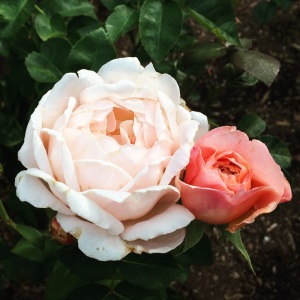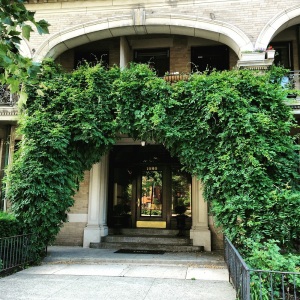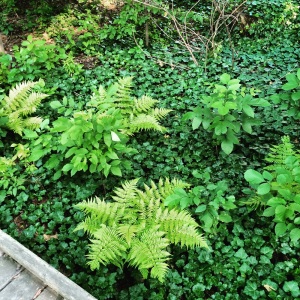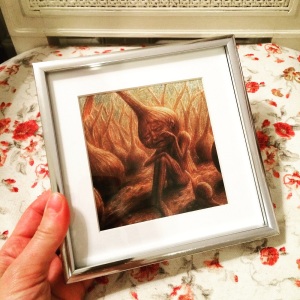Ordinary pleasures, and a post borrowed from the incomparable Theodora Goss
I have a day off today. A brilliant, beautiful, probably uninteresting, definitely uncomplicated day off. I have a day off tomorrow as well. Completely empty, full of promise, loaded with things I could do, might even do, probably won't do. How perfectly wonderful.
I have been so busy lately: working scheduled hours, picking up extra days when coworkers need a day off (I love those girls, and am always happy to lend a hand, but I think I need to work on saying no...hence my two days off in a row!!), writing blog posts (not here, sorry, but check out SageWoman), polishing finished manuscripts, beginning new ones (visiting the Arctic with a walrus named Wallace), and finally, struggling with a decision that will most definitely affect the girls I work with, as well as my family. (That has finally been resolved, thank the gods. A decision that takes three weeks to reach has most definitely been carefully thought over.)
So what will I do with my two wonderful days off? All three of my children are home today as well. (as I type this they are video gaming. Not what I intend for the entire day.) We have chores to do: laundry, finding the boys' room under the littlest one's toys, baking chocolate chip brownies...okay, that's not a chore. Running along the edge of town by the river is a beautiful bike path, and I think we need some outside time today. I had thought about visiting a local college museum, but sadly, they are all closed on Mondays. Well, we have tomorrow as well.
In other words, today I am going to do nothing but enjoy ordinary pleasures. Tidying my house and tending my back step garden. Laughing with my children. Listening to Mister G as we clean the boys' room. Singing 'Sneaky Chihuahua' at the top of our voices as we mix brownies. Snapping photos and picking wildflowers on our walk along the river. Pressing wildflowers for Liam's 'Leaf Book,' as he calls it. (I call it an herbarium.) Afternoon tea taken on the back steps, shaded by the grapevine, listening to bees buzz about the tomato and squash blossoms.
Usually on my days off I'm zipping around, trying to get as much done as I can so things are sorted out for the days I have to work. The result? I'm grumpy, overtired, and just plain snarky. (That's not the word my daughter used, but I'm trying to be PG here.) On reviewing my journal entries from those days, I see a litany of complaints. What good is a day off if you don't enjoy it? Beginning today, and hopefully continuing along from now on, I intend to take my days off in as leisurely a manner as I can. Sort my earrings and toss strays into the craft box. Make an Anthropologie style bracelet. (Thank you Bev @ Flamingo Toes...I love your stuff!) Take the time to make stuffed zucchini for dinner...mmmmmm. Write more. Take photos of everything that catches my eye. You get the idea. Share some of yours, if you would. I'd love to hear from you. In the meantime, I will leave you with this beautifully thoughtful post from Theodora Goss' blog, followed with links to places that are relevant to this post, and yes, a recipe for stuffed zucchini. Enjoy!
I’m not kidding, I really did organize my taxes. It’s such a relief, having all that paperwork organized into individual folders, appropriately labeled. I know, it’s a lot less exotic than flying to Budapest. But this summer has been about trying to catch up on all the ordinary things that, to be honest, I’ve neglected. I’ve lived in my apartment for a year, and it’s still not entirely decorated. Granted, decorating takes a while, at least the way I do it, but still . . . I’d like to have a nice place to live in. And that takes putting in the time, doing the work. So this summer is about doing the ordinary things: working, organizing, catching up.
What I’ve found, staying in Boston this summer, is the pleasure of the ordinary. The pleasure, for example, of watching the procession of flowers. Luckily, I live in the midst of gardens: there are gardens in front of the brownstones all up and down my street, more formal gardens in city squares or close to children’s playgrounds, and even conservation areas where I can go for walks beside rivers or ponds, under tall trees. Just now the roses and clematis are almost over, although this week I still found some perfect roses in a formal rose garden not too far from me. This was one of them:

The lilies have started blooming, and the linden trees are in flower. I’m lucky to live on a street with linden trees, so I can smell the sweet odor every time I step outdoors. It seems to fall from the trees . . . Every time one type of flower fades, I feel sad because it means that summer is passing. But at the same time, it’s fascinating to see them, like the best fashion show ever. Nothing we create is as beautiful as the flowers. Mother Nature is, after all, the greatest artist. And I love walking around the city, looking at the old buildings with their beautiful details. Architecture lost both beauty and detail for a while — we were poorer for that, and are just starting to find those two things again.

What we really lost, I think, is the understanding that beauty and joy come from the small, the ordinary. Take those enormous contraptions of steel and glass created by the most famous contemporary architects. They are rarely beautiful, and they rarely give us joy. If we got rid of every single one of them, it would not impact our lives in a significant way. Compare them to a honeybee, so small and intricate. Isn’t the bee more beautiful? And if we got rid of every single one of them . . . well then, we’d be in trouble.
I don’t know what happened to our sense of the small and ordinary, but I think we need to get it back. Recently, I started watching a television show from the 1960s, and I was startled by how small things were: hotel rooms, women’s clothes, international crime syndicates. (All right, if you must know, it’s Mission Impossible. I love watching a show that is almost pure plot . . .) There are ways in which we live in a better world. No Cold War, for one. But I think as we progress, we always lose something. In this case, at least, I think we can get it back.
After I went to the rose garden, I walked to the conservancy I mentioned, which is a wetland. There is a path through the woods . . . (I thought this would be a good place for a metaphor.)

We can make a conscious decision to reclaim the small, the ordinary. We can care more about honeybees than skyscrapers. Knitting than international finance. (Don’t get me wrong: you should try to understand international finance. We need to understand what is being done to our world, if only because voting intelligently is one of those small things that make a large impact, like honeybees.) We can learn to cook or play an instrument. We can organize our taxes. Clean our bathrooms. (That’s on the agenda for today.) There is so much meaning in those small acts, and the truth is, when we do something large, the meaning of it usually comes from the small components anyway. If we write a novel, the meaning comes from all those hours we spent at our computer, trying to find the right word. From each edit. From the lessons we learned about ourselves while writing.

Aren’t the ferns gorgeous? I had to take a picture of them as I walked through the forest. It was like walking through a green world, made up of all the small things: beech leaves rustling overhead, white trunks of birches, ferns by the path, rabbits hopping under the bushes, looking at me as though wondering what I was doing in their living room, and the magnificent blue heron that was standing in the pond, with a blue heron reflected in the pond water beneath him. I thought, I’d like to have something like this, a connection of this sort, every day of my life.
Then I went home and did the small things there: made dinner, finished some sewing I’d been putting off for a while, intimidated as always by my sewing machine because tension is so complicated . . . but no, my Singer behaved perfect. And then I did something I’m really quite proud of: I figured out how to use my new mat cutting board and cut some mats. It took a while to get used to, but look:

That’s a small card by the artist Virginia Lee, of a weeping Onion Man. I found the square frame at Goodwill, and I thought, it will be too small. But with a one-inch mat, it fit the picture quite well. (I had to cut the mat twice. The trick, I found, is to use a real mat board under the mat board you’re cutting, rather than the cardboard included with your mat cutter.) Virginia gave me the card when I visited her village, in England. So I’m not saying don’t do the large things — I would not have missed my trip to England for the world. But remember to do the small ones, because those are where we mostly find meaning . . . and joy.


Open Tue - Fri 11-4 & Sat - Sun 10-5
Beneski Museum of Natural History
11 Barrett Hill Road
Amherst College
Amherst, MA 01002-5000
(413) 542-2165
Tekla Harms, Director and Professor of Geology
Alfred Venne, Museum Education Curator (avenne@amherst.edu)
Kate Wellspring, Collections Curator
Museum Director and Professor of Geology, Tekla Harms, speaks about Edward Hitchcock and introduces Kevin Baines '76 who then discusses dinosaur extinction.
I have been so busy lately: working scheduled hours, picking up extra days when coworkers need a day off (I love those girls, and am always happy to lend a hand, but I think I need to work on saying no...hence my two days off in a row!!), writing blog posts (not here, sorry, but check out SageWoman), polishing finished manuscripts, beginning new ones (visiting the Arctic with a walrus named Wallace), and finally, struggling with a decision that will most definitely affect the girls I work with, as well as my family. (That has finally been resolved, thank the gods. A decision that takes three weeks to reach has most definitely been carefully thought over.)
So what will I do with my two wonderful days off? All three of my children are home today as well. (as I type this they are video gaming. Not what I intend for the entire day.) We have chores to do: laundry, finding the boys' room under the littlest one's toys, baking chocolate chip brownies...okay, that's not a chore. Running along the edge of town by the river is a beautiful bike path, and I think we need some outside time today. I had thought about visiting a local college museum, but sadly, they are all closed on Mondays. Well, we have tomorrow as well.
In other words, today I am going to do nothing but enjoy ordinary pleasures. Tidying my house and tending my back step garden. Laughing with my children. Listening to Mister G as we clean the boys' room. Singing 'Sneaky Chihuahua' at the top of our voices as we mix brownies. Snapping photos and picking wildflowers on our walk along the river. Pressing wildflowers for Liam's 'Leaf Book,' as he calls it. (I call it an herbarium.) Afternoon tea taken on the back steps, shaded by the grapevine, listening to bees buzz about the tomato and squash blossoms.
Usually on my days off I'm zipping around, trying to get as much done as I can so things are sorted out for the days I have to work. The result? I'm grumpy, overtired, and just plain snarky. (That's not the word my daughter used, but I'm trying to be PG here.) On reviewing my journal entries from those days, I see a litany of complaints. What good is a day off if you don't enjoy it? Beginning today, and hopefully continuing along from now on, I intend to take my days off in as leisurely a manner as I can. Sort my earrings and toss strays into the craft box. Make an Anthropologie style bracelet. (Thank you Bev @ Flamingo Toes...I love your stuff!) Take the time to make stuffed zucchini for dinner...mmmmmm. Write more. Take photos of everything that catches my eye. You get the idea. Share some of yours, if you would. I'd love to hear from you. In the meantime, I will leave you with this beautifully thoughtful post from Theodora Goss' blog, followed with links to places that are relevant to this post, and yes, a recipe for stuffed zucchini. Enjoy!
Ordinary Pleasures
Last summer, I spent a month in Budapest, taking a class in Hungarian. This summer, I organized my taxes.I’m not kidding, I really did organize my taxes. It’s such a relief, having all that paperwork organized into individual folders, appropriately labeled. I know, it’s a lot less exotic than flying to Budapest. But this summer has been about trying to catch up on all the ordinary things that, to be honest, I’ve neglected. I’ve lived in my apartment for a year, and it’s still not entirely decorated. Granted, decorating takes a while, at least the way I do it, but still . . . I’d like to have a nice place to live in. And that takes putting in the time, doing the work. So this summer is about doing the ordinary things: working, organizing, catching up.
What I’ve found, staying in Boston this summer, is the pleasure of the ordinary. The pleasure, for example, of watching the procession of flowers. Luckily, I live in the midst of gardens: there are gardens in front of the brownstones all up and down my street, more formal gardens in city squares or close to children’s playgrounds, and even conservation areas where I can go for walks beside rivers or ponds, under tall trees. Just now the roses and clematis are almost over, although this week I still found some perfect roses in a formal rose garden not too far from me. This was one of them:

The lilies have started blooming, and the linden trees are in flower. I’m lucky to live on a street with linden trees, so I can smell the sweet odor every time I step outdoors. It seems to fall from the trees . . . Every time one type of flower fades, I feel sad because it means that summer is passing. But at the same time, it’s fascinating to see them, like the best fashion show ever. Nothing we create is as beautiful as the flowers. Mother Nature is, after all, the greatest artist. And I love walking around the city, looking at the old buildings with their beautiful details. Architecture lost both beauty and detail for a while — we were poorer for that, and are just starting to find those two things again.

What we really lost, I think, is the understanding that beauty and joy come from the small, the ordinary. Take those enormous contraptions of steel and glass created by the most famous contemporary architects. They are rarely beautiful, and they rarely give us joy. If we got rid of every single one of them, it would not impact our lives in a significant way. Compare them to a honeybee, so small and intricate. Isn’t the bee more beautiful? And if we got rid of every single one of them . . . well then, we’d be in trouble.
I don’t know what happened to our sense of the small and ordinary, but I think we need to get it back. Recently, I started watching a television show from the 1960s, and I was startled by how small things were: hotel rooms, women’s clothes, international crime syndicates. (All right, if you must know, it’s Mission Impossible. I love watching a show that is almost pure plot . . .) There are ways in which we live in a better world. No Cold War, for one. But I think as we progress, we always lose something. In this case, at least, I think we can get it back.
After I went to the rose garden, I walked to the conservancy I mentioned, which is a wetland. There is a path through the woods . . . (I thought this would be a good place for a metaphor.)

We can make a conscious decision to reclaim the small, the ordinary. We can care more about honeybees than skyscrapers. Knitting than international finance. (Don’t get me wrong: you should try to understand international finance. We need to understand what is being done to our world, if only because voting intelligently is one of those small things that make a large impact, like honeybees.) We can learn to cook or play an instrument. We can organize our taxes. Clean our bathrooms. (That’s on the agenda for today.) There is so much meaning in those small acts, and the truth is, when we do something large, the meaning of it usually comes from the small components anyway. If we write a novel, the meaning comes from all those hours we spent at our computer, trying to find the right word. From each edit. From the lessons we learned about ourselves while writing.

Aren’t the ferns gorgeous? I had to take a picture of them as I walked through the forest. It was like walking through a green world, made up of all the small things: beech leaves rustling overhead, white trunks of birches, ferns by the path, rabbits hopping under the bushes, looking at me as though wondering what I was doing in their living room, and the magnificent blue heron that was standing in the pond, with a blue heron reflected in the pond water beneath him. I thought, I’d like to have something like this, a connection of this sort, every day of my life.
Then I went home and did the small things there: made dinner, finished some sewing I’d been putting off for a while, intimidated as always by my sewing machine because tension is so complicated . . . but no, my Singer behaved perfect. And then I did something I’m really quite proud of: I figured out how to use my new mat cutting board and cut some mats. It took a while to get used to, but look:

That’s a small card by the artist Virginia Lee, of a weeping Onion Man. I found the square frame at Goodwill, and I thought, it will be too small. But with a one-inch mat, it fit the picture quite well. (I had to cut the mat twice. The trick, I found, is to use a real mat board under the mat board you’re cutting, rather than the cardboard included with your mat cutter.) Virginia gave me the card when I visited her village, in England. So I’m not saying don’t do the large things — I would not have missed my trip to England for the world. But remember to do the small ones, because those are where we mostly find meaning . . . and joy.
Stuffed Young Zucchini
Open Tue - Fri 11-4 & Sat - Sun 10-5
Beneski Museum of Natural History
11 Barrett Hill Road
Amherst College
Amherst, MA 01002-5000
(413) 542-2165
Tekla Harms, Director and Professor of Geology
Alfred Venne, Museum Education Curator (avenne@amherst.edu)
Kate Wellspring, Collections Curator
Museum Director and Professor of Geology, Tekla Harms, speaks about Edward Hitchcock and introduces Kevin Baines '76 who then discusses dinosaur extinction.
(Holiday Closures 1/1 - 7/3-7/4 - 11/25 & 11/26 - 12/24-12/26)
And from
Education.com: http://www.education.com/activity/article/Herbarium_Sheets/
Be a Botanist: Make Herbarium Sheets
Botany, the study of plants, is a very important field of
science. Many of the medicines we use, as well as most of the foods we
eat, come from plants. Botanists cannot go into the field to study every
single kind of plant from all over the world so they create an
herbarium, which is a kind of plant library. The herbarium library is
composed of sheets of paper holding a plant that has been dried and
glued onto the paper. Each plant is labeled so that the botanist can
studied that plant at any time. In this activity we are going to press
and dry a flower and then make our own herbarium sheet!
What You Need:
- 1 11" x 16" sheet of heavy card stock
- Printer paper
- Plant (It can be any plant but make it's small enough to fit onto your paper and that you get some of the root system. Note: If you collect your plant in the wild, be careful not to collect a protected species and make sure you have permission.)
- Pen
- Pencil
- Glue
- Newspapers
- Heavy books
What You Do:
- Place the plant between two sheets of newspaper and in between some heavy books. Stack more heavy books on top. This process will press your flower and dry it out, and can take up to a week or more.
- When your flower is pressed, remove it from the newsprint and carefully glue it to the 11x16 paper. Have the paper go the long way (16") so that you have plenty of room for your plant.
- Take your printer paper, cut a 3" x 4" piece of paper and glue
this onto the bottom right corner of your herbarium sheet. On this piece
of paper write:
- Specimen: (See if you can find the Latin name in a flower book)
- Collector: (your name)
- Where it was collected:
- When it was collected:
- To make it more complete, label your flower parts with a pencil. See if you can identify the stem, leaf, petals, pistol, stamen and root. When you are done you will have a beautiful piece of art and a valuable piece of science. Conitnue to make sheets and then hole-punch them to make an herbarium book
Have a great day all!

Comments
Post a Comment